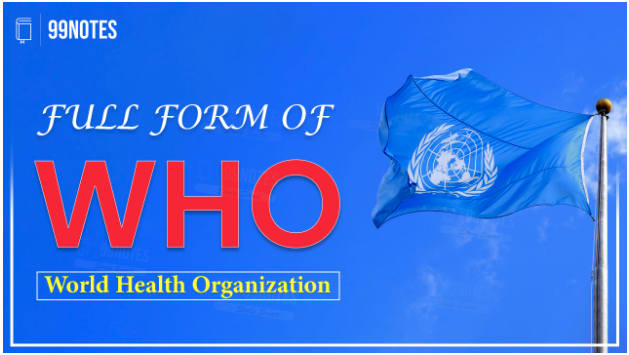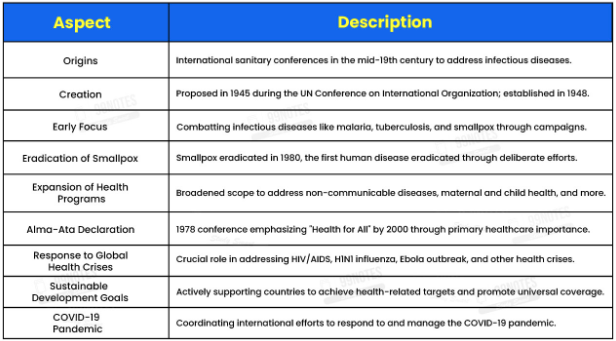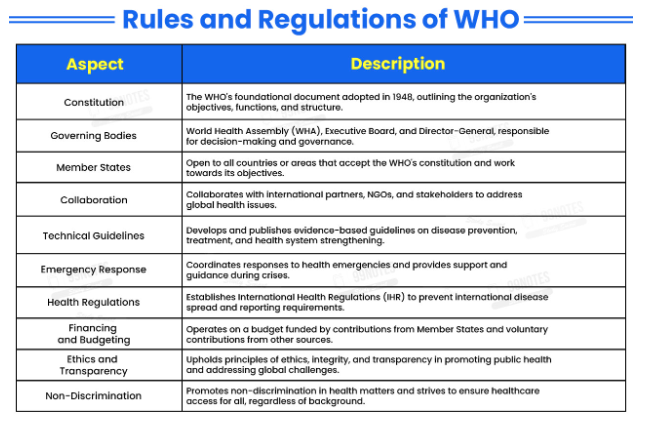WHO Full Form, Origin, Objectives & Functions
WHO Full Form

➤ What is WHO Full Form?
The WHO Full form representing “World Health Organization”. At the moment, the world is dealing with a slew of issues. Indeed, effective global health policy implementation is urgently required. Not just the state but also the non-governmental groups must step forward to ensure that a nation’s citizens act ethically. This is where groups such as the World Health Organization emerge. The World Health Organization is a specialist institution overseen by the United Nations that deals with public health issues. The primary goal of this group is for all populations to be capable of achieving the best level of health attainable.
What is WHO?
The World Health Organization is a specialized institution overseen by the United Nations that deals with Public Health issues. This organization’s role is to achieve maximum health success for everybody. The union was founded on 7th July 1948, with its headquarters in Geneva, Switzerland. The World Health Organisation had its inaugural conference on health problems in July 1948. The United Nations Social and Economic Council is the organization’s parent body.
According to WHO, the population of people in a country should be able to achieve Universal Health Coverage and promote their health and well-being in all aspects of life. WHO guides nations in need that seek to address the issue of health crises. The organization’s major mission is to promote health on a national and global scale, to assist vulnerable members of society, and to keep the globe secure.
➤ What are the objectives of WHO?
The WHO continues to pursue the following objectives:
- WHO serves as the government’s directing body for health-related problems
- WHO maintains excellent connections and effective engagement with the United Nations and other similar bodies.
- It lends a helping hand to the government of a country in improving healthcare services in that country.
- One of the most essential responsibilities is to encourage collaboration among various professional groups in a society that have a part in any type of health service.
Aside from that, the institution has a plan specifically designed to improve society’s health standards. It would be accomplished by taking into account different socioeconomic aspects that may aid in the improvement of the country’s health infrastructure. As a consequence, the pro-poor, human-rights-based approach and gender responsiveness methods would be integrated.
➤ Contributions of WHO?
The World Health Organization provides individuals with health advice and ensures that health standards are maintained in society. Aside from that, the organization serves as an informing body for the other nations that maintain watch whenever a nation becomes engulfed in breakouts. One of the WHO’s most significant accomplishments has been the global elimination of smallpox and the promotion of new methods of managing TB on a massive scale.
According to WHO, all children in the country should be compulsorily immunized with vaccinations against infectious illnesses. Tetanus, measles, diphtheria, whooping cough, TB and polio vaccinations are on the list. Apart from this, WHO has a section called the Global Public Health Network that is in charge of issuing prior warnings to any potential pandemics.
In India, the organization’s primary goal is to improve health standards and preserve equity in the country, ensuring that the most disadvantaged members of society have access to competent healthcare at the appropriate time. With the National Strategic Plan for Malaria Elimination, the institution has concentrated and created a goal to eradicate malaria from India by 2027.
WHO Challenges
The World Health Organization faces new obstacles with each new step it takes. Its reliance on benefactor reserves is certainly a serious concern for the institution. The agency has also been chastised for how it handled the Ebola epidemic and the subsequent coronavirus pandemic. The business has also faced several obstacles in the past. One example was the signing of the WHA 12-40 agreement with the IAEA. The clause defined WHO’s reliance on this context. As a result, individuals questioned the organisation on the grounds that it lacked the power to make autonomous decisions. However, it was later established that the WHO had autonomy in making health-related decisions.

FAQ’s Related to WHO full form
WHO, founded in 1948, is a United Nations organisation that unites governments, partners, and people to promote health, keep the world safe, and protect the vulnerable- so that everyone, everywhere, can achieve the greatest level of health.
What are the five functions of WHO?
WHO is the in charge of Global Health Leadership,
- Guiding the health research agenda,
- Creating norms and standards,
- Articulating evidence-based policy alternatives,
- Providing technical assistance to nations, and
- Monitoring and analysing health trends.
The WHO was established on 7th July, 1948.
United Nations Social and Economic Council is its parent body.
Other Related Links:
| Full Form | UNESCO Full form |
| SAARC full form | ASEAN Full form | UNICEF Full Form | IMF Full form |
| CRZ Full Form | BRICS Full Form |
| COP Full Form | UPSC Notes |

